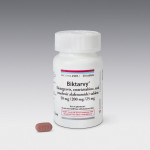A drug-resistance mutation in HIV’s protease gene may actually be advantageous and make the virus more sensitive to antiretroviral drug regimens containing either Reyataz (atazanavir) or Invirase (saquinavir), according to a paper published online ahead of print in AIDS Research and Therapy.
Typically, once a person’s HIV acquires enough mutations to resist an antiretroviral (ARV), the virus may also become partially or fully resistant to other ARVs in the same drug class, even if those medications haven’t been used. This is called cross-resistance.
Occasionally, however, resistance to one drug can actually increase the effectiveness of another. For example, if the M184V mutation in HIV’s reverse transcriptase gene develops while a person is being treated with either Epivir (lamivudine) or Emtriva (emtricitabine), the anti-HIV activity of Retrovir (zidovudine) becomes more pronounced.
Until recently, it was assumed that the L76V mutation in HIV’s protease gene, which can arise during therapy with a protease inhibitor, can make other protease inhibitors less active against the virus. This assumption was based on test-tube studies that looked at the genes of this particular mutation. Since then, however, lab studies have hinted that this mutation, rather than reducing the effectiveness, might actually increase the effectiveness of two protease inhibitors: Reyataz and Invirase.
To test this theory, Frank Weismann, MD, from the HIV and Hepatitis Research Group at the Praxen Zentrum Blodelstrasse in Aachen, Germany, and his colleagues looked at the medical records of 46 heavily treatment experienced individuals who received care at their network of clinics between 1999 and 2009. All the study participants had the L76V protease mutation at the start of the study, in this case caused by either Kaletra (lopinavir plus ritonavir) or Lexiva (fosamprenavir), or an earlier formulation of Lexiva called Agenerase (amprenavir).
The participants were split into three groups based on how they changed their regimens. One group (group A) switched up their entire regimen, going off Kaletra, Lexiva or Agenerase altogether. The other two groups stayed on those drugs, but added either Reyataz or Invirase (group B), or they added drugs other than Reyataz or Invirase (group C).
Over the course of two years of follow-up the difference between the three groups, in terms of viral suppression, was striking. Initially, 50 percent of those in group A and 67 percent of those in group B were able to get their virus below 50 copies. None of the people in group C did so.
Over time, however, the ability to remain virally suppressed diverged widely between groups A and B. After 96 weeks, 67 percent of those in group B continued to have full HIV suppression, compared with only 17 percent of those in group A. This was true despite the fact that genotypic resistance testing predicted that people in group B would actually have fewer active drugs in their regimen than those in group A.
Weismann and his coauthors caution that their results are preliminary. What’s more, there is evidence that the increased susceptibility to Reyataz or Invirase can be reduced if a second mutation, called the L90M, is also present. As Invirase can cause the L90M mutation, it is possible that Reyataz would be safer to use.
Nevertheless, the authors conclude: “In case of L76V-occurrence, [Reyataz] and/or [Invirase] may represent encouraging options for patients in deep salvage situations.”
Advertisement
Advertisement
Advertisement






Comments
Comments